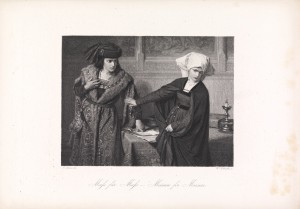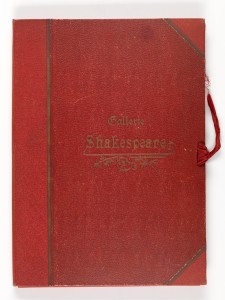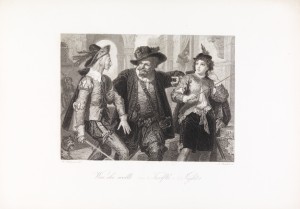Shakespeare in Steel: exploring links between Edward Dowden’s ‘Shakespeare Scenes & Characters’ and the ‘Gallerie Shakespeare’ portfolio of engravings. Part III.
On the 15th July 2016, the University of Melbourne’s highly anticipated After Shakespeare exhibition was officially opened, in the Noel Shaw Gallery of the Baillieu Library. Marking the 400th anniversary of the year of the Bard’s death, the exhibition plays host to a number of artefacts and ephemera that highlight Shakespeare’s lasting legacy throughout the centuries, with particular focus on his reception in Australia.
Amongst the intriguing stories contained in the cases is a puzzling connection between an 1876 English book of Shakespearian commentaries and engravings, and a separately issued portfolio of 22 engravings with a French title. Helen Kesarios, a student volunteer in the Cultural Collections Projects Program, has been investigating possible connections between the two works, drawing on original correspondence located at the British Library.
Part I told the story of the Shakespearian scholar, Edward Dowden, and the publication of his exquisitely illustrated text, Shakespeare Scenes & Characters (London : Macmillan and Co, 1876). Part II explored the background to the German engravings which feature in Dowden’s text.
The third instalment in this three-part story continues here, investigating links with a separately issued French portfolio of the engravings…
Part III – The French portfolio of German engravings
Also in Case 6, and accompanying Dowden’s text is a selection of loose prints from Australian composer and pianist Percy Grainger’s “Gallerie Shakespeare”, a red folio of twenty-two steel engravings identical to those contained in Dowden’s text, but bearing no publisher’s imprint. It is unknown how they came to be in Grainger’s collection, but their existence therein is unsurprising, given the strong affinity Grainger had with literature from a young age, particularly Nordic literature. As John Bird notes in his biography:
‘From the time Percy was four or five years old a certain period each day was set aside for reading out loud. The writings of Hans Christian Andersen were the first pieces of literature which he thus encountered. Later came the Icelandic Sagas of Njal and ‘Grettir the Strong’ and he was determined that one day he would learn a Scandinavian language so that he could read the Sagas in their original form. From the Sagas he turned to early English history with a strong emphasis on that period when the Nordic influence was greatest due to the Viking invasions. By the age of ten he had devoured a huge array of literature which included such material as Freeman’s History of the Norman Conquest and the Anglo-Saxon Chronicles’.[i]
 In correspondence with Macmillan and Co., Dowden repeatedly makes reference to a “Shakespeare-Galerie” or “Shakespeare Gallery”, which provided the prints for use in his book. As exciting as it may be to assume that Grainger’s “Gallerie Shakespeare” is one and the same, such a conclusion is found to be highly unlikely. Upon returning to the Preface, we learn that in fact, the “Shakespeare-Galerie” Dowden refers to is Friedrich Pecht’s “Shakespeare-Galerie: Charakter und Scenen aus Shakespaere’s Dramen”, a publication containing the Dowden prints with accompanying text in German by Pecht, what Dowden refers to as ‘a pleasant and cultured little causerie on each of the plays illustrated by the designers’.[ii] In selecting the text for his own book, Dowden decided ultimately that the essays by Pecht, ‘though bright and genial, seemed more suitable to the German than to the English reader, and it was thought that their place could with some advantage be supplied by a select body of extracts from the best writers, English, American, French and German, who have contributed to the criticism of Shakespeare’.[iii]
In correspondence with Macmillan and Co., Dowden repeatedly makes reference to a “Shakespeare-Galerie” or “Shakespeare Gallery”, which provided the prints for use in his book. As exciting as it may be to assume that Grainger’s “Gallerie Shakespeare” is one and the same, such a conclusion is found to be highly unlikely. Upon returning to the Preface, we learn that in fact, the “Shakespeare-Galerie” Dowden refers to is Friedrich Pecht’s “Shakespeare-Galerie: Charakter und Scenen aus Shakespaere’s Dramen”, a publication containing the Dowden prints with accompanying text in German by Pecht, what Dowden refers to as ‘a pleasant and cultured little causerie on each of the plays illustrated by the designers’.[ii] In selecting the text for his own book, Dowden decided ultimately that the essays by Pecht, ‘though bright and genial, seemed more suitable to the German than to the English reader, and it was thought that their place could with some advantage be supplied by a select body of extracts from the best writers, English, American, French and German, who have contributed to the criticism of Shakespeare’.[iii]
Thus, there still remains no definitive answer for how Grainger’s loose prints in the “Gallerie Shakespeare” portfolio came into being, how they fell into his hands, and their exact publication relationship with Dowden’s Shakespeare Scenes & Characters. Throughout my research, I have heard numerous theories on the matter, for example, that the prints actually belonged to Ella Grainger (Percy Grainger’s wife), as they were found in her belongings. Alternatively, it has been suggested hat they may have been a gift to Percy from his father. While we may never know for certain their origin, both they and Dowden’s Shakespeare Scenes and Characters remain two wonderful pieces of Shakespeariana that are definitely worth viewing in person.
Helen Kesarios, Research Assistant – After Shakespeare exhibition
[i] John Bird, Percy Grainger, Elek Books Ltd, London, 1976, p. 11.
[ii] Dowden, Shakespeare Scenes and Characters, p. viii.
[iii] ibid.



Leave a Reply